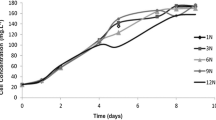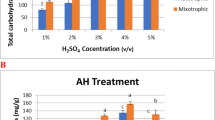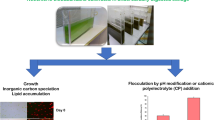Abstract
Neochloris oleoabundans (=Ettlia oleoabundans) is a green microalga that has great potential for the production of biodiesel. To achieve economically viable processes for the production of biodiesel from microalgae, the use of wastewater is highly recommended. However, there are no reports on the cultivation of N. oleoabundans utilizing anaerobic digestates of vinasse or stillage, which is a highly polluting wastewater from the alcohol industry. A first group of experiments was conducted, aiming to establish the optimal culture conditions of N. oleoabundans (UTEX 1185) using anaerobic effluents of vinasse (AEV) in bubble columns incubated under controlled conditions. The highest culture density was obtained in a medium containing 6 % of such effluents with a daily addition of sodium bicarbonate (1 g L−1). The total lipid content varied from 17.7 to 38.5 % for a range of 2 to 8 % of AEV with added sodium bicarbonate. A second group of experiments using 6 % AEV + sodium bicarbonate and flat plate photobioreactor-incubated outdoors was performed. An increase of 62 % in cell density compared to the value registered in Bold’s basal medium (BBM) was observed. Furthermore, a high ammonium–nitrogen removal (85.2 %) and a high flocculation efficiency (42 % after 30 min) indicate that dual-purpose systems aimed at producing high densities of lipid-enriched biomass of this green microalga are feasible. The uses of supplemental bicarbonate and organic waste as a source of nutrients are very important factors that contribute to reducing the cost of production.








Similar content being viewed by others
References
Abomohra A, Wagner M, El-Sheekh M, Hanelt D (2013) Lipid and total fatty acid productivity in photoautotrophic fresh water microalgae: screening studies towards biodiesel production. J Appl Phycol 25:931–936
APHA, American Public Health Association (1998) Methods for biomass production. In: Standard methods for the examination of water and wastewater. American Public Health Association, Baltimore
Cenciani K, Bittencourt-Oliveira MC, Feigl BJ, Cerri CC (2011) Sustainable production of biodiesel by microalgae and its application in agriculture. Afr J Microbiol Res 5:4638–4645
Chisti Y (2007) Biodiesel from microalgae. Biotechnol Adv 25:294–306
Christenson L, Sims R (2011) Production and harvesting of microalgae for wastewater treatment, biofuels and bioproducts. Biotechnol Adv 29:686–702
Elvira N, Ruíz-Marín A, Canedo-López Y (2013) Effect of nitrogen content and CO2 consumption rate by adding sodium carbonate in the lipid content of Chlorella vulgaris and Neochloris oleoabundans. Int J Environ Prot 3:13–19
Emerson S, Hedges J (2008) Chemical oceanography and the marine carbon cycle. Cambridge University Press, Cambridge, pp 101–133
Feng D, Chen Z, Xue S, Zhang W (2011) Increased lipid production of the marine oleaginous microalgae Isochrysis zhangjiangensis (Chrysophyta) by nitrogen supplement. Bioresour Technol 102:6710–6716
Franchino M, Comino E, Bona F, Riggio VA (2013) Growth of three microalgae strains and nutrient removal from an agro-zootechnical digestate. Chemosphere 92:738–744
Garzón-Sanabria AJ, Ramirez-Caballero SS, Moss FEP, Nikolov ZL (2013) Effect of algogenic organic matter (AOM) and sodium chloride on Nannochloropsis salina flocculation efficiency. Bioresour Technol 143:231–237
Gouveia L, Oliveira AC (2009) Microalgae as a raw material for biofuels production. J Ind Microbiol Biotechnol 36:269–274
Gouveia L, Marques AE, Lopes da Silva T, Reis A (2009) Neochloris oleabundans UTEX #1185: a suitable renewable lipid source for biofuel production. J Ind Microbiol Biotechnol 36:821–826
Granados MR, Acién FG, Gómez C, Fernández-Sevilla JM, Molina-Grima E (2012) Evaluation of flocculants for the recovery of freshwater microalgae. Bioresour Technol 118:102–110
Joy EF, Barnard J (1975) Commercial acids and bases. In: Welcher FJ (ed) Standard methods of chemical analysis. Robert E. Krieger Publishing New York, pp 534–629
Klausmeier CA, Litchman E, Daufresne T, Levin SA (2004) Optimal nitrogen-to-phosphorus stoichiometry of phytoplankton. Nature 429:171–174
Levine RB, Costanza-Robinson M, Spatafora GA (2011) Neochloris oleoabundans grown on anaerobically digested dairy manure for concomitant nutrient removal and biodiesel feedstock production. Biomass Bioenergy 35:40–49
Li Y, Horsman M, Wang B, Wu N, Lan CQ (2008) Effects of nitrogen sources on cell growth and lipid accumulation of green alga Neochloris oleoabundans. Appl Microbiol Biotechnol 81:629–636
Marques SSI, Nascimento IA, de Almeida PF, Chinalia FA (2013) Growth of Chlorella vulgaris on sugarcane vinasse: the effect of anaerobic digestion pretreatment. Appl Biochem Biotechnol 171:1933–1943
Moheimani NR, Borowitzka MA, Isdepsky A, Fon-Sing S (2013) Standard methods for measuring growth of algae and their composition. In: Borowitzka MA, Moheimani NR (eds) Algae for biofuels and energy. Springer, Dordrecht, pp 265–284
Murray KE, Shields JA, Garcia ND, Healy FG (2012) Productivity, carbon utilization, and energy content of mass in scalable microalgae systems. Bioresour Technol 114:499–506
Nguyen TDP, Frappart M, Jaouen P, Pruvost J, Bourseau P (2014) Harvesting Chlorella vulgaris by natural increase in pH: effect of medium composition. Environ Technol 35:1378–1388
Olguín EJ, Doelle HW, Mercado G (1995) Resource recovery through recycling of sugar processing by-products and residuals. Resour Conserv Recycl 15:85–94
Olguín EJ, Galicia S, Mercado G, Pérez T (2003) Annual productivity of Spirulina (Arthrospira) and nutrient removal in a pig wastewater recycling process under tropical conditions. J Appl Phycol 15:249–257
Olguín EJ, Sánchez-Galván G, González-Portela RE, López-Vela M (2008) Constructed wetland mesocosms for the treatment of diluted sugarcane molasses stillage from ethanol production using Pontederia sagittata. Water Res 42:3659–3666
Olguín EJ, Mercado G, Hernández ME (2011) La contaminación del agua. In: Cruz A (ed) La biodiversidad en Veracruz: estudio de estado, volumen I, Comisión Nacional para el Conocimiento y Uso de la Biodiversidad, Gobierno del Estado de Veracruz. Universidad Veracruzana, Instituto de Ecología, México, pp 369–380
Olguín EJ (2012) Dual purpose microalgae-bacteria-based systems that treat wastewater and produce biodiesel and chemical products within a Biorefinery. Biotechnol Adv 30:1031–1046
Olguín EJ (2013) Plant and microalgae biomass for the production of biofuels and restoration of polluted environments within a biorefinery. Invited Lecture at the 2013 World Biotechnology Congress. Boston, MA. USA Abstract Book:18
Olguín EJ, Castillo OS, Mendoza A, Tapia K, González-Portela RE, Hernández-Landa VJ (2015) Dual purpose system that treats anaerobic effluents from pig waste and produce Neochloris oleoabundans as lipid rich biomass. New Biotechnol. doi:10.1016/j.nbt.2014.12.004
Pagnanelli F, Altimari P, Trabucco F, Toro L (2014) Mixotrophic growth of Chlorella vulgaris and Nannochloropsis oculata: interaction between glucose and nitrate. J Chem Technol Biotechnol 89:652–661
Park JBK, Craggs RJ, Shilton AN (2011) Wastewater treatment high rate algal ponds for biofuel production. Bioresour Technol 102:35–42
Pittman JK, Dean AP, Osundeko O (2011) The potential of sustainable algal biofuel production using wastewater resources. Bioresour Technol 102:17–25
Pruvost J, Van Vooren G, Le Gouic B, Couzinet-Mossion A, Legrand J (2011) Systematic investigation of biomass and lipid productivity by microalgae in photobioreactors for biodiesel application. Bioresour Technol 102:150–158
Rakesh S, Saxena S, Dhar DW, Prasanna R, Saxena AK (2014) Comparative evaluation of inorganic and organic amendments for their flocculation efficiency of selected microalgae. J Appl Phycol 26:399–406
Ritchie RJ (2006) Consistent sets of spectrophotometric chlorophyll equations for acetone, methanol and ethanol solvents. Photosynth Res 89:27–41
Robles-Pliego, M., Olguín, E.J., Hernández-Landa J., González-Portela, R.E., Sánchez-Galván, G., Cuervo-López F.M. Dual purpose system for the treatment of water from a polluted river and the production of Pistia stratiotes biomass within a biorefinery. (Accepted in CLEAN – Soil, Air & Water)
Salim S, Vermuë MH, Wijffels RH (2012) Ratio between autoflocculating and target microalgae affects the energy-efficient harvesting by bio-flocculation. Bioresour Technol 118:49–55
Sirin S, Trobajo R, Ibanez C, Salvadó J (2012) Harvesting the microalgae Phaeodactylum tricornutum with polyaluminum chloride, aluminium sulphate, chitosan and alkalinity-induced flocculation. J Appl Phycol 24:1067–1080
Travieso L, Benítez F, Sánchez E, Borja R, León M, Raposo F, Rincón B (2008) Assessment of microalgae pond for post-treatment of the effluent from an anaerobic fixed bed reactor treating distillery wastewater. Environ Technol 29:985–992
Valderrama LT, Del Campo C, Rodríguez CM, De-Bashan LE, Bashan Y (2002) Treatment of recalcitrant wastewater from ethanol and citric acid production using the microalga Chlorella vulgaris and the macrophyte Lemna minuscula. Water Res 36:4185–4192
Vandamme D, Foubert I, Fraeye I, Meesschaert B, Muylaert K (2012) Flocculation of Chlorella vulgaris induced by high pH: role of magnesium and calcium and practical implications. Bioresour Technol 105:114–119
Wang B, Lan CQ (2011) Optimizing the lipid production of the green alga Neochloris oleoabundans using box-Behnken experimental design. Can J Chem Eng 89:932–939
Wijffels RH, Barbosa MJ (2010) An outlook on microalgal biofuels. Science 329:796–799
Wu Z, Zhu Y, Huang W, Zhang C, Li T, Zhang Y, Li A (2012) Evaluation of flocculation induced by pH increase for harvesting microalgae and reuse of flocculated medium. Bioresour Technol 110:496–502
Yang BJ, Zheng L, Han XT, Zheng MG (2013a) Development of TLC-FID technique for rapid screening of the chemical composition of microalgae diesel and biodiesel blends. Fuel 111:344–349
Yang Y, Minninberg B, Tarbet A, Weathers P (2013b) At high temperature lipid production in Ettlia oleoabundans occurs before nitrate depletion. Appl Microbiol Biotechnol 97:2263–2273
Yildirim A, Demirel Z, Isleten-Hosoglu M, Akgun IH, Hatipoglu-Uslu S, Conk-Dalay M (2014) Carotenoid and fatty acid compositions of an indigenous Ettlia texensis isolate (Chlorophyceae) under phototrophic and mixotrophic conditions. Appl Biochem Biotechnol 172:1307–1319
Acknowledgments
The authors acknowledge the financial support from the grant FOMIX VER-2009-C03-127097 provided by the State of Veracruz and the National Council of Science and Technology (CONACYT) and from the grant 152931 provided by the Ministry of Energy (SENER) and CONACYT, México. They also acknowledge the technical support from José Luis Domínguez Zavala.
Author information
Authors and Affiliations
Corresponding author
Rights and permissions
About this article
Cite this article
Olguín, E.J., Dorantes, E., Castillo, O.S. et al. Anaerobic digestates from vinasse promote growth and lipid enrichment in Neochloris oleoabundans cultures. J Appl Phycol 27, 1813–1822 (2015). https://doi.org/10.1007/s10811-015-0540-6
Received:
Revised:
Accepted:
Published:
Issue Date:
DOI: https://doi.org/10.1007/s10811-015-0540-6




